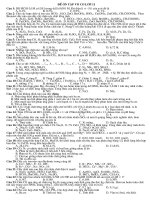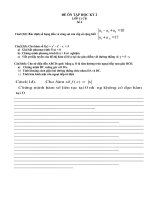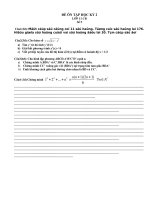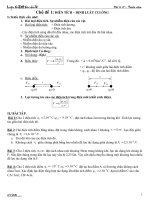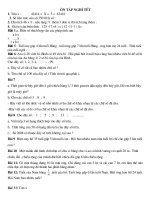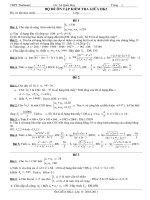Đề ôn tập HSG các cấp lớp 11, 12 (1)
Bạn đang xem bản rút gọn của tài liệu. Xem và tải ngay bản đầy đủ của tài liệu tại đây (182.72 KB, 14 trang )
MOCK TEST 1
I. LISTENING
Part 1. Question s 1 – 6
Choose two letters, A – E
1 – 2: What TWO things did respondents say they liked most about doing the crossword?
A It helped them spell complex technical terms.
B It was an enjoyable experience.
C It helped them concentrate effectively.
D It increased their general motivation to study.
E It showed what they still needed to study.
3 – 4: In which TWO areas did these research findings differ from those of the original
study?
A
B
C
D
E
Students’ interest in doing similar exercises.
How much students liked doing the crossword.
Time taken to do the crossword.
Gender differences in appreciation.
Opinions about using crosswords for formal assessment.
5 – 6: What TWO skills did Leela and Jake agree they had learned from doing the
project?
A
B
C
D
E
How to manage their time effectively.
How to process numerical data.
How to design research tools.
How to reference other people’s work.
How to collaborate in research.
Part 2. Questions 7 – 15
You will hear part of a radio program in which food historian Andrew Dalford talks
about pepper, one of the commonest spices. For questions 7 – 15, complete the
sentences with a word or short phrase.
Andrew Dalford’s recently published book about the history of spices is entitled 7…
Dangerous taste …
The colour of pepper is related to when the 8 .. HARVESTS .. occurs.
In the past, dishonest dealers would add cheaper plant materials such as 9…seeds .. and
…BERRIES .. to sacks of pepper.
Andrew uses the term 10… symbol status ..describe the social importance of pepper
throughout history.
Peppercorns could be used in financial transactions, like paying 11…for rents … and
clearing debts.
Together with ivory and 12… silk ., pepper was regarded as a luxury item in the Roman
Empire.
In medicine, both pepper and 13…gingers .. were used to treat certain conditions.
Made into an ointment, pepper was used to treat irritated 14…itchy or burning skin .. and
to relieve pain.
Pepper in solution or as a powder was used to keep 15.. insects….. away.
Part 3. Listen to a radio programme about Biomimicry, the science of copying
nature in order to create new technologies and fill in the missing information. Write
NO MORE THAN THREE WORDS taken from the recording for each answer in
the spaces provided.
Biomimicry imitates nature’s structures, processes and systems to create new ideas.
Velcro was invented in (1) _ 1941 _. It was developed after its inventor observed the
sticking qualities of one particular plant’s seed heads.
Wood has the beneficial feature of being able to (2) _ hold nails _
The synthetic ‘wood’ created for the post office will not change shape according to
surrounding environmental conditions.
The Namibian Fog Basking beetle uses its ability to (3)_ harvest moisture _ in order to
live in harsh conditions.
A waxy finish on the beetle’s shell repels water and aids the formation of large droplets.
The Sahara Forest project utilised this concept in the design of a (4) _ greenhouse _.
The ‘Able Project’ uses worms from the composting process as an input to the fish farm.
The extinction of one species of (5) _ frogs _has prevented scientists from finding a
cure for excess stomach acid.
Your answers
1.
2.
3.
4.
5.
II. LEXICO-GRAMMAR
Part 1: Choose the best answer.
1 To make the sauce, ……………. a small bar of chocolate and melt it over a pan
of water.
A splash
B. hack
C. grate
D. cut
2 The desk was so …………….. with papers that it was hard to find anything.
A burdened
B. cluttered
C. overrun
D. muddled
3 I’m afraid we haven’t got a spare bed. Can you …………. with a mattress on
the floor?
A make do
B. make by
C. make over
D. make up
4. What ………… the smoke and the noise, the party made me feel quite ill.
A. if
B. with
C. through
D. of
5. Speed limits on the road …………….. to protect pedestrians as well as
motorists.
A. serve
B. prove
C. succeed
D. intend
6. Tax ………….. deprives the state of several million pounds a year.
A. retention
B. desertion
C. escapism
D. evasion
7. When all the students …………….., the professor began his lecture.
A. sat
B. were sitting
C. seated
D. were seated
8. What are you going to do when all your money ……………
A. runs down
B. runs deep
C. runs dry
D. runs short
9. Fred says that his present job does not provide him with enough ………………
for his organising ability.
A. scope
B. space
C. capacity
D. range
10. A few political extremists ………… the crowd to attack the police.
A. animated
B. agitated
C. incited
D. stirred
11. Although the new library service has been very successful, its future is
______________certain.
A. at any rate
B. by no means
C. by all means
D. by any chance
12. Some people can _______________ out of their shyness as soon as they are
20.
A. move
B. change
C. grow
D. turn
13. Please don’t talk about the day – I want to ______________ it all behind me.
A. block
B. stir
C. summon
D. put
14. Advertisers often aim their campaigns at young people as they have
considerable spending_____________?
A. power
B. strength
C. force
D. ability
15. The strike was ______________ owing to a last-minute arrangement with the
management
A. called off
B. broken up
C. set back
D.put down
16. The weather is usually mild, although we sometimes get a cold________at he
beginning of the year.
A. spell
B. term
C. interval
D. wave
17. He had a ___________ escape since the bullet came within inches of his head.
A. slender
B. close
C. near
D. narrow
18. I can’t tell you the exact amount, but I can give you a ______ estimate.
A. smooth
B. tidy
C. rough
D. similar
19. ______benefits include a new car and free health insurance.
A.Well
B. Fringe
C. Edge
D.Verge
20. You haven’t heard all the facts so don’t________to conclusion.
A. walk
B. go
C.fly
D.jump
21. Demand for the product is expected to peak five years from now and then to
____.
A. taper off
B. fall down
C. set back
D. drift away
22. Alan's photo was slightly too large for the frame so he decided to ____ it.
A. hack
B. chop
C. slice
D. trim
23. Although the patient received intensive treatment, there was no ____
improvement in her condition.
A. decipherable
B. legible
C. discernible
D. intelligible
24. Lack of sleep over the last few months is finally ____ Jane.
A. coming over
B. getting on with C. putting on
D. catching up with:
negatively affect
25. During the evening football match the stadium was illuminated by ____.
A. spotlights
B. flashlights
C. highlights
D. floodlights
Part 2: Write the correct form of each bracketed word.
Slave Narratives
In the wake of the bloody Nat Turner (1. rebellion) in Southampton County,
Virginia, in 1831, an increasingly fervent (2. ANTI - slavery) movement in the
United States sponsored (3. FIRSTHAND) autobiographical accounts of slavery
by fugitives from the South in order to make (4. ABOLITIONISTS) of a largely
(5. INDIFFERENT) white Northern readership. From 1830 to the end of the
slavery era, the fugitive slave narrative dominated the (6. LITERARY) landscape
of antebellum black America. The Narrative of the Life of Frederick Douglass, an
American Slave, Written by Himself (1845) gained the most attention, (7.
ESTABLISHING) Frederick Douglass as the leading African American man of
letters of his time. By predicating his struggle for freedom on his (8. SOLITARY)
pursuit of literacy, education, and (9. independence), Douglass portrayed himself
as a (10. SELF-MADE) man, which appealed strongly to middle-class white
Americans.
III. READING COMPREHENSION
Part 1: For questions 1 – 10, read the text below and decide which answer (A, B, C
or D) best fits each gap.
There is an example at the beginning (0).
What we know about music and the brain
Work on the human brain has (0) …….. how different parts are centre of activity for
different skills, feelings, perceptions and so on. It has also been shown that the left and
right halves, or hemispheres, of the brain are (1) …….. for different functions. While
language is processed in the left, or analytical hemisphere, music is processed in the
right, or emotional hemisphere. (2) …….. of music like tone, pitch and melody are all
probably processed in different parts of the brain. Some features of musical experience
are processed not just in the (3) ………….. parts of the brain, but in the visual ones. We
don’t yet fully understand the (4) …….. of this.
The tempo of music seems to be (5) …….. related to its emotional impact, with fast
music often (6) …….. as happier and slower music as sadder. It is the same with the
major biological rhythm of the body: our heart (7) …….. quickens when we’re happy, but
slows when we’re sad. Military music may have (8) …….. from attempts to get us ready
for (9)…….. by using fast drumming to (10) …….. our hearts into beating faster.
1 A amenable
B dependable
C responsible
D reliable
2 A Views
3 A auditory
4 A expectations
5 A surely
6 A felt
7 A pulse
8 A evolved
9 A battle
10 A activate
B Aspects
B visual
B implications
B plainly
B endured
B speed
B extended
B fight
B motivate
C Factors
C imaginary
C assumptions
C evidently
C encountered
C pace
C advanced
C quarrel
C stimulate
D Pieces
D sensual
D propositions
D directly
D touched
D rate
D elevated
D struggle
D animate
Part 2: Read the text below and think of the word which best fits each space.
Food for a Future
John Wynne-Tyson was an original thinker (0)…WHOSE… best-known book ‘Food for
a Future’ was published in 1975. In this classic work, a case was (1) PUT forward for
(2)..WHAT.. can only be described as a more responsible and humane attitude towards
the world’s food resources. It had gradually (3)… BECOME… clear to Wynne-Tyson
that the economics and ecology of meat production did not (4)…MAKE .. sense. What
justification was (5)…THERE.. he argued, for using seven tonnes of cereal to produce
one tonne of meat?
Even today, the book’s succinct style makes it compulsively readable. (6)…
ALTHOUGH… his approach is basically an emotional one. Wynne-Tyson goes to great
lengths to back (7)…UP…. every statement with considerable supporting evidence and
statistical data. Thus, even (8)…THOSE/SOME… of us who are widely read (9)…
THROUGH/IN…. this subject of vegetarianism will gain fresh insights from this book. It
is generally agreed that his most skillful achievement is the slow revelation of his main
thesis (10)…SINCE… the arguments unfold.
Part 3: Read the passage and answer the questions.
As inventors tire of stock market instability, the idea of owning a piece of real
estate is gaining in popularity. Now, not everyone has what it takes to become a
landlord, but if you can make a go of it, it certainly has the potential to become a
good money-earner. Here are some tips from successful real estate mogul, Janet
Anderson, on how to start building up your property portfolio.
According to Janet, one of the best ways to identify a bargain is to hunt for
foreclosures. Foreclosures are properties banks have repossessed because their
owners were unable to meet the mortgage repayments. Banks want a quick sell on
these places, Janet says. They want to cut their losses and get their money back as
quickly as possible. Developing a network – making connections with city clerks
and bank employees who know which properties are about to be sold – can be an
excellent way to identify such bargains. And bargains they certainly can prove to
be; in a recent firesale auction (‘firesale auction’ is the phrase that has been coined
to describe auction-room events dedicated entirely to the disposal of repossessed
assets) A house with a market value nearing $ 1,000,000, but with a low reserve
price designed to encourage bidders and secure a quick sale, went for $ 450,000;
that’s a whopping 55% discount.
It’s also important to be realistic though and not stretch yourself too far financially.
Janet says the biggest mistake you can make is to borrow too much or over-borrow.
For first time investors, lenders usually demand bigger payments because you
haven’t got a proven track record. That’s more of your money on the table and,
therefore, should anything go wrong, you’re in for a big financial hit.
Her business partner, James Nylles, is in complete agreement on this point. He also
highlights the fact that the mortgage payments and deposits are only part of the
long term cost of buying a rental property. There is also the cost of repairs,
administration and maintenance, rental manager’s fees, insurance and so on,
all of which require you to hold a significant amount of money in reserve.
Failure to factor this in when calculating how much you can afford to part with in
mortgage repayments can lead to disaster.
One of the biggest traps for first time investors, according to Nylles, is the
temptation to pay over the odds to get the property you desire. Buyers often get
carried away, especially in the auction-room setting, which can get quite
competitive and even descend into a racket of one-upmanship. They end up paying
top-dollar and landing themselves in a financial situation they can ill afford to be
in. Remember, you are in the property game to make money, so the more money
you have to pay upfront for a property, the less likely you are to recoup your
investment in the long run. The good news, however, is that the housing market is
not very hot at the moment, which means the danger of overpaying is not so great.
Always set emotions to one side and think from a purely business perspective. The
question of your liking or disliking the property is irrelevant. As Nylles points out:
“you will not be living there.” Business decisions are made in the cold hard light of
day; your objective is to minimize your outlay and maximize your return. Whether
you secure a huge home in pristine condition or a tiny flat with barely room to
stretch in is irrelevant – if the tiny flat gets you a better return on your investment
then the choice is a no-brainer.
And last of all, do your homework. You’ve got to get to know the location in which
you are going to invest. Look out for areas which are earmarked for government
investment. Urban renewal areas are often very attractive since house and rental
prices in such places are low right now but can be expected to rise in the not too
distant future. The range of local amenities, safety and the state of the local
economy are all important factors to consider, too. As the old saying goes,
‘location, location, location’. Invest in a good location and you will maximize your
rental income.
Questions 1-7: Answer questions bellow using NO MORE THAN THREE WORDS
for each answer.
1. what are investors getting fed up with? Stock market instability
2. Janet Anderson is involved in the sale of property. What is another
phrase used in paragraph 1 to describe this type of business?
property portfolio
3. What is one of the best ways to identify a bargain in the property
market? Hunt for foreclosures
4. Failure to meet your what, can cause your home to be repossessed?
mortgage repayments
5. What do banks want to get back quickly on foreclosed properties?
money
6. Developing networks is an excellent way to find what?
Bargains
7. What is the biggest error of judgement first time investor can make,
according to Anderson? Over-borrow
Questions: 8-14 - In spaces 8-14 bellow, write YES, NO, NOT GIVEN
8. Banks demand larger deposits from first time property investors.Y
9. By making a larger deposit, investors can limit their personal financial
risk. N
10. There are a lot of long term costs to take into consideration before
purchasing a rental Y
Part 4: Read the passage and choose the best answer:
Although only a small percentage of the electromagnetic radiation that is emitted
by the Sun is ultraviolet (UV) radiation, the amount that is emitted would be
enough to cause severe damage to most forms of life on Earth were it all to reach
the surface of the earth. Fortunately, all of the Sun’s ultraviolet radiation does not
reach the earth because of a layer of oxygen, called the ozone layer, encircling the
earth in the stratosphere at an altitude of about 15 miles above the earth. The ozone
layer absorbs much of the Sun’s ultraviolet radiation and prevents it from reaching
the earth.
Ozone is a form of oxygen in which each molecule consists of three atoms (O3)
instead of the two atoms (O2) usually found in an oxygen molecule. Ozone forms
in the stratosphere in a process that is initiated by ultraviolet radiation from the
Sun. UV radiation from the Sun splits oxygen molecules with two atoms into free
oxygen atoms, and each of these unattached oxygen atoms then joins up with an
oxygen molecule to form ozone. UV radiation is also capable of splitting
up ozone molecules; thus, ozone is constantly forming, splitting, and reforming in
the stratosphere. When UV radiation is absorbed during the process of ozone
formation and reformation, it is unable to reach Earth and cause damage there.
Recently, however, the ozone layer over parts of the earth has been diminishing.
chief among the culprits in the case of the disappearing ozone, those that are really
responsible, are the chlorofluorocarbons (CFCs). CFCs meander up from Earth
into the stratosphere, where they break down and release chlorine. The released
chlorine reacts with ozone in the stratosphere to form chlorine monoxide (ClO) and
oxygen (O2). The chlorine then becomes free to go through the cycle over and over
again. One chlorine atom can, in fact, destroy hundreds of thousands of ozone
molecules in this repetitious cycle, and the effects of this destructive process are
now becoming evident.
1. According to the passage, ultraviolet radiation from the Sun
A. is causing serve damage to the earth’s ozone layer
B. is only a fraction of the Sun’s electromagnetic radiation
C. creates electromagnetic radiation
D. always reaches the earth
2. The word ‘encircling’ in paragraph 1 is closest in meaning to
A. rotating
B. attacking
C. raising
D. surrounding
3. It is stated in the passage that the ozone layer
A. enables ultraviolet radiation to reach the earth
B. reflects ultraviolet radiation
C. shields the earth from a lot of ultraviolet radiation
D. reaches down to the earth
4. According to the passage, an ozone molecule
A. consists of three oxygen molecules
B. contains more oxygen atoms than the usual oxygen molecule does
C. consists of two oxygen atoms
D. contains the same number of atoms as the usual oxygen molecule
5. The word “free” could be best replaced by
A. liberal
B. gratuitous
C. unconnected
D. emancipated
6. Ultraviolet radiation causes oxygen molecules to
A. rise to the stratosphere
B. burn up ozone molecules
C. split up and reform as ozone
D. reduce the number of chlorofluorocarbons
7. The pronoun “it” refers to
A. radiation
B. process
C. formation
D. damage
8. The word “culprits” is closest in meaning to
A. Guilty parties
B. Detectives
C. Group members
D. Leaders
9. According to the passage, what happens after a chlorine molecule reacts
with an ozone molecule?
A. The ozone beaks down into three oxygen atoms
B. Two different molecules are created
C. The two molecules combine into one molecule
D. Three distinct molecules result
10. The paragraph following the passage most likely discusses
A. The negative results of the cycle of ozone destruction
B. where chlorofluorocarbons (CFCs) come from
C. the causes of the destruction of ozone molecules
D. how electromagnetic radiation is created
IV. WRITING
Exercise 1: Read the following extract and use your own words to summarise it.
Your summary should be about 80-100 words long. You must not copy the
original.
Let children learn to judge their own work. A child learning to talk
does not learn by being corrected all the time: if corrected too much, he will
stop talking. He notices a thousand times a day the difference between the
language he uses and the language those around him use. Bit by bit, he makes
the necessary changes to make his language like other people’s. In the same
way, children learning to do all the other things they learn to do without
being taught – to walk, run, climb, whistle, ride a bicycle – compare their
own performances with those of more skilled people, and slowly make the
needed changes. But in school we never give a child a chance to find out
his mistakes for himself, let alone correct them. We do it all for him. We
act as if we thought that he would never notice a mistake unless it was
pointed out to him, or correct it unless he was made to. Soon he becomes
dependent on the teacher. Let him do it himself. Let him work out, with the
help of other children if he wants it, what this word says, what the answer is
to that problem, whether this is a good way of saying or doing this or not.
If it is a matter of right answers, as it may be in mathematics or science,
give him the answer book. Let him correct his own papers. Why should we
teachers waste time on such routine work? Our job should be to help the child
when he tells us that he can’t find the way to get the right answer. Let’s end
all this nonsense of grades, exams, marks.. Let us throw them all out, and
let the children learn what all educated persons must some days learn, how to
measure their own understanding, how to know what they know or do not
know.
Let them get on with this job in the way that seems most sensible to
them, with our help as school teachers if they ask for it. The idea that there is
a body of knowledge to be learnt at school and used for the rest of one’s life
is nonsense in a world as complicated and rapidly changing as ours. Anxious
parents and teachers say, ‘But suppose they fail to learn something essential,
something they will need to get on in the world?’ Don’t worry! If it is
essential, they will go out into the world and learn it.
The given passage gives readers an insight into how should children be
allowed to be autonomous. In fact,
Furthermore,
Exercise 2: Write a short report for a university lecturer describing the information shown
below.
The bar chart below shows the estimated sales of jeans for two companies next year in Turkey.
The pie chart shows the projected market share of the two companies in jeans at the end of next
year.
Write at least 150 words.
Exercise 3. Discipline is an ever increasing problem in modern schools. Some
people think that discipline should be the responsibility of teachers, while others
propose that this is the role of parents. Discuss both sides and give your opinion.
(35p.)
Write an essay of about 300-350 words.
